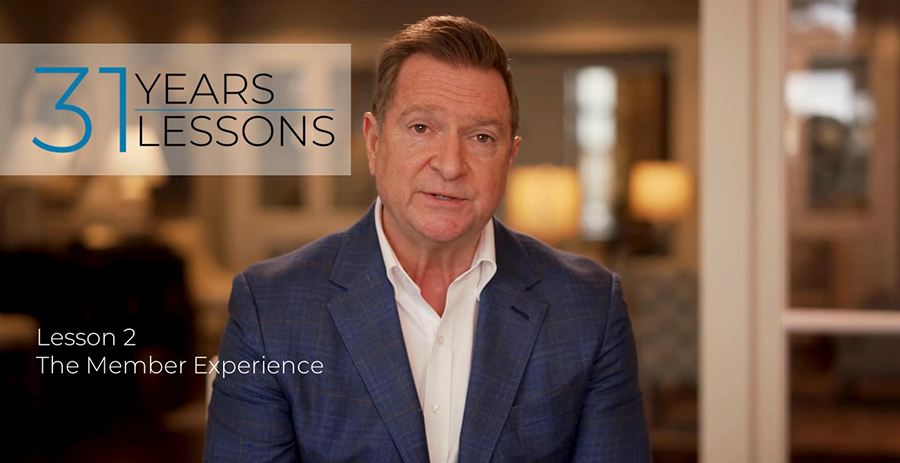
Lesson #7
of GGA Director Colin Burns’
31 years | 31 Lessons
Collaborative Leadership

Lesson #6
of GGA Director Colin Burns’
31 years | 31 Lessons speaks to
how to provide inclusive hospitality

The GGA Partners 31 Years | 31 Lessons featuring Colin Burns continues with explaining how coming from a place of goodness will be remembered.

GGA Director Colin Burns, CCM, brings his print ad to life in a new video highlighting his beliefs about the role of an executive search consultant.

GGA Director Colin Burns, CCM, shares his Winged Foot Golf Club lessons learned about the member experience.

Managing a private club is not an easy task. It requires knowledge, stamina, fortitude, patience and a sense of humor. With each new year comes new challenges, opportunities and lessons to learn.
When GGA Director Colin Burns, CCM, joined the firm, he shared the lessons he learned over a lifetime in the hospitality industry, as an advocate for club management and his three decades as the general manager of Winged Foot Golf Club with our team. In hearing those lessons, we were reminded how success comes from doing the right thing every day.
We asked Colin to record his common sense and professional advise for us to share with you. Today we present the first of Colin’s 31 Years | 31 Lessons videos. We will be releasing all 31 on our LinkedIn page over the next several months in the hope you find these lessons helpful as you navigate your own path to success as a leader in our industry.
What do people think when you walk into a room, open your mouth to speak, or engage with others? Are they excited for what is about to happen? How do they see you, and how do they experience you? What happens as a result of your presence?
Senior leaders are increasingly discussing Executive Presence – what it is and how to have more of it. No matter how you define it, it has much to do with how we influence others. To be clear, Executive Prescence is not about how many followers you have on your social profiles but rather, how you connect, communicate, care, and impact others.
In his recent book, “The Gift of Influence”, Tommy Spaulding reveals how we can be more mindful and effective in wielding influence throughout a lifetime of connecting with others. He outlines research that suggests the average person will influence up to 80,000 people in their lifetime – about the size of a football stadium. He suggests that “If you commit to living a life of positive influence, you will never look at your personal and professional relationships the same way again.” “Leadership is not about influence. It is influence.”
Influence has everything to do with leading in the boardroom, the staff room, and beyond. Here are some considerations on how to elevate your presence, your influence and your life.
Trust – The Strongest Foundation
All relationships start and end with trust. Think about the best board relationship of your career or greatest team you have ever been a part of. What was the level of trust?
If you want to build trust with others, make sure you are trustworthy yourself as well as trusting of others. This doesn’t mean establishing blind trust without questioning. It means that we always have the intention of trust.
Years ago, author Stephen Covey likened trust to an emotional bank account. As with a real bank account, we want the balance to be at its highest. And so, it is true with a trust account. When the balance is high, the relationship is easy, more productive, and positive influence occurs. On the other hand, a low trust account breeds an environment of fear, a lack of engagement, negative influence and limited results.
Ensure you are making more deposits than withdrawals into your trust account with others: Be upfront. Be clear with your intentions. Do what you say you will do. Find the answers. Show you care. Acknowledge others.
Communication – A Main Ingredient
Most great influencers are extraordinary communicators. They understand that the words they say are powerful, and the way they say them is even more. They get to the point – and they have one! Brevity and clarity are their style. They say what they mean and mean what they say. They speak with good intentions. They have the good of the other person and the organization in mind, not themselves. A great communicator uses the language of vision and possibility.
In the leadership development practice, we have a saying “Say Less. Ask More.” The best leaders exercise the skill of listening more and speaking less. They are curious. They don’t have all the answers and genuinely seek them out. They ask powerful questions that engage others, explore solutions, and bring about growth. The focus shifts to others, not themselves.
A positive influencer also knows how their body language and voice add to or detract from their impact. They are purposeful yet speak with integrity and authenticity. They read the room, they remain calm under pressure, and they connect and engage others. Their eye contact, facial expressions and gestures are appropriately warm and powerful at the same time. They influence.
Humility – If You Don’t Have It, Find It
No question, you need to be competent in your role, but do you need to be the smartest person in the room?
The most purposeful leaders have the gift of humility. They let the results speak. They always give credit where it is due. They show up as competent, kind, caring leaders, and they often get amazing results. Their reputation speaks for itself, without their own input. They are keenly self-aware and always learning and growing.
Are you aware of how you “land” with others? Do you speak the language of team or individual? What message are you trying to send? Be acutely aware.
The great news about executive presence and influence is that they are learned skills. Start where you are. Dive in. Get feedback from those that you trust. Acquire some training or coaching. Change some habits and see how your positive influence soars – in the boardroom and beyond.
To have a discussion about how GGA’s Leadership Development and Coaching services can benefit your club, contact michael.gregory@ggapartners.com
In fact, it is quite simple…you need to ask members what they want. Michael Gregory and Dr. Eric Brey at GGA Partners can tell you with certainty that developing a broad and deep understanding of members’ wants, needs, expectations, and fears is a matter of faithfully applying proven practices of attitudinal research.
Dr. Brey, a PhD-accredited professor at the University of Wisconsin – Stout, is an expert at leveraging analytics to implement dependable customer-centric strategy and hone it on what truly impacts satisfaction. And it all begins with asking members what they want. Sometimes referred to as qualitative analysis, members’ viewpoints are normally collected within small groups and sometimes validated in expanded follow-up listening sessions. In his work with GGA, Dr. Brey has implemented this science within private clubs where understanding members’ attitudes are so important.
In order to measure what matters are of greatest importance to a given club’s members, attitudinal surveys prove to be a trustworthy tool. Establishing the proportion and intensity of members’ attitudes has become even more important in a time when members want to know that their viewpoints were taken into account.
Gregory, having worked at GGA since 2007, is expert at administering private club surveys. He emphasizes that attitudinal surveys in private clubs are essential because the relationship between the club and its members is an emotional and often intense one. In recent years, club leaders have become more reliant on member surveys as the sophistication of such surveys goes deeper into members’ viewpoints. Not the stuff of satisfaction surveys, an attitudinal survey seeks to quantify and measure members concerns and expectations, willingness to fund certain capital projects, and identify the characteristics – by analyzing underlying data – to provide club leaders with clearcut insight into what members want. Five factors that are consistently revealed in member surveys include:
Insights vary from club to club and require careful and objective analysis of underlying demographic data to enable the board to understand how members align and differ on certain topics. Dr. Brey advises careful analytical discipline and measurement. “There is no substitute for patient and transparent data analysis,” he says.
At the end of the day, Brey and Gregory confirm that it is possible to know what members want. One simply needs to ask the right questions in the right way.
This piece was authored by Henry DeLozier, Partner, for the National Club Association‘s Winter 2023 Issue of Club Director Magazine.
Connect with Henry – henry.delozier@ggapartners.com